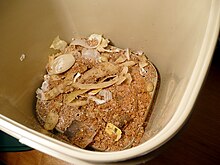 Today I finally made a trip to Bunnings in order to spend the gift voucher I received from Hannah for my birthday. I also had some cash that was given to me by my partner's mum so I had a fairly generous budget to spend.
Today I finally made a trip to Bunnings in order to spend the gift voucher I received from Hannah for my birthday. I also had some cash that was given to me by my partner's mum so I had a fairly generous budget to spend. I've been wanting to get into composting for a while now, and made a half-hearted beginning on a compost 'heap' in the backyard, which has really become more of a supplemental feeding station for the chooks, who delight to rip through it every day and pick out bits of it to eat. I don't mind them doing that, so much because they're turning it over at the same time, but the problem is that I don't then, have much other than straw and chicken poop for my compost and it's just not working!
So today with money and gift voucher in hand, I cruised the aisles at Bunnings and looked for a solution.
I'm actually quite surprised at what the budget stretched to!
I purchased an indoor (Bokashi) composter and two 60ltr plastic garbage cans which I will convert to use as outdoor compost bins, thus keeping the compost in and the chooks out. I also got a lovely new garden fork and a 15m hose which will be used to extend the current hose which is too short to reach up to the chicken coops and the potato beds that we have dug behind the chicken coops.
I'm very pleased with all this, and can't wait to get started on creating compost. In fact, the bokashi compost bucket has already been started as I type!
Below is some information about Bokashi composting for those who might not have heard of it before.
Wikipedia:
Bokashi composting
Bokashi is a method of intensive composting. It can use an aerobic or anaerobic inoculation to produce the compost. Once a starter culture is made, it can be used to extend the culture indefinitely, like yoghurt culture. Since the popular introduction of effective microorganisms (EM), Bokashi is commonly made with only molasses, water, EM, and wheat bran.
In home composting applications, kitchen waste is placed into a container which can be sealed with an air tight lid. These scraps are then inoculated with a Bokashi EM mix. This usually takes the form of a carrier, such as rice hulls, wheat bran or saw dust, that has been inoculated with composting micro-organisms. The EM are natural lactic acid bacteria, yeast, and phototrophic bacteria that act as a microbe community within the kitchen scraps, fermenting and accelerating breakdown of the organic matter. The user would place alternating layers of food scraps and Bokashi mix until the container is full. Liquid "compost tea" is drained once or twice a week and can be diluted 1:100 and added to plants as fertilizer, or poured directly down drains to help clean them.[17] Once the container is full, it is left to ferment for an additional 2 weeks in the container, and then buried under 6-8 inches of soil, in ground or in a non-reactive container. After another two weeks buried under soil, the food scraps should be broken down into rich compost.
http://en.wikipedia.org/wiki/Bokashi_composting#Bokashi_composting

No comments:
Post a Comment